48 trends reshaping the film industry: Part 4 - Industry changes

This is the last instalment in a four-part series chronicling 48 trends and changes in the film industry.
To compile this list, I have been back through all of my old research, conducted new projects, read outside research and solicited suggestions from my industry readership (thank you to everyone who contributed). The result is a list of 48 trends and changes affecting the film industry. For readability, I have split them into four groups:
Industry changes (see below)
37. Cannes festival and market are getting bigger
The Cannes festival ("Festival de Cannes") and film market ("Marché du Film") are the biggest events in the industry calendar and attract film professionals from all over the world. The 2005 Cannes festival and market had 20,804 accredited professionals in attendance whereas by 2015 that had grown to 32,465 (156% increase in just ten years).
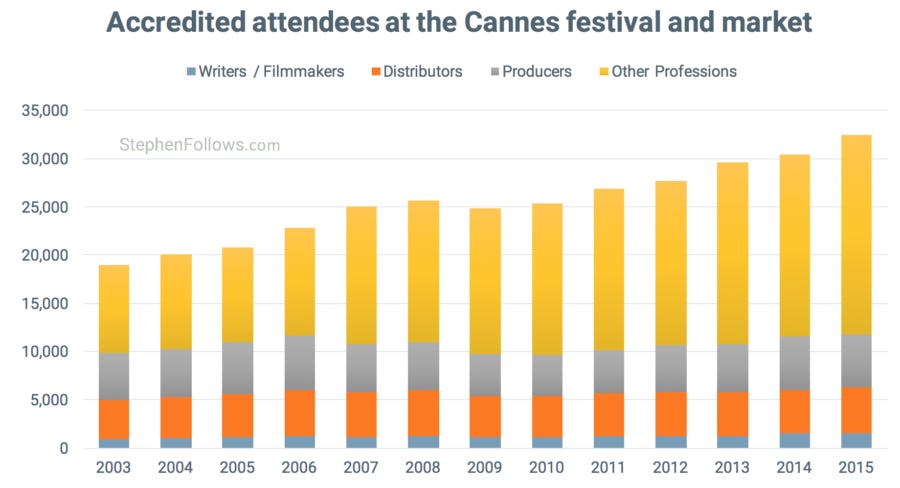
Further reading: Cannes film festival mysteries explained (via Nicolas Cage)
38. Drama films have taken over Cannes
The films shortlisted at the Cannes film festival are seen by many to represent the very best as-yet-unreleased films. However, they are hardly a representative cross-section of all films made, as the overwhelming majority are dramas. Dramas have always dominated the Cannes line-up since its inception. 72% of the films shortlisted in Cannes in the 1940s were dramas, whereas in the first five years of our current decade that figure has grown to 93%
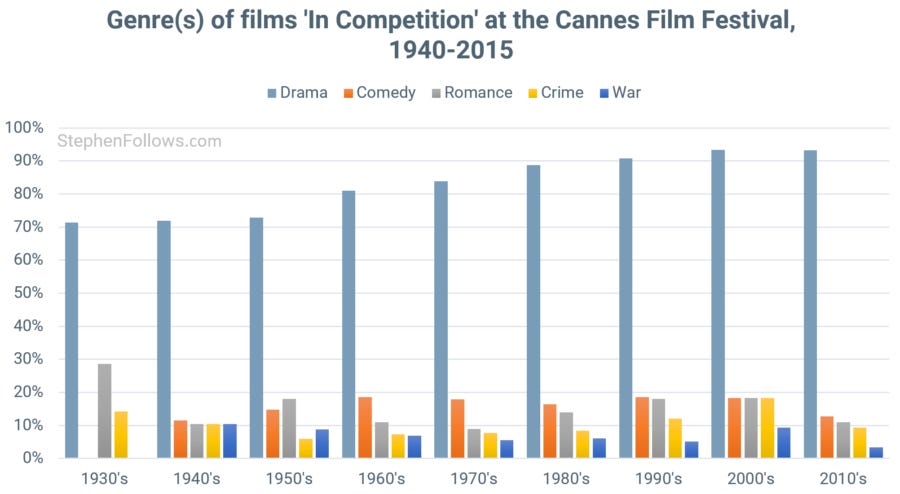
I used the data I studied of Cannes-nominated films to create the 'perfect' Cannes film - a mythical movie which synthesises the most successful elements of previous years. This film would be a French drama called “Ma Vie Pour La Femme”, directed by Ken Loach, written by Jean-Claude Carrière, starring Michel Piccoli and Isabelle Huppert (plus Gérard Depardieu to provide comic relief) and produced by Alain Sarde and Rémi Burah.
As for the content of the film, I used all fifty of the most commonly-used words in Cannes synopses to create a plot:
The film takes us on a journey through the two lives of young David… and how he gave everything up for Her.
He first met ‘The Woman’ on the day his father met death and soon their love was as new as the world is old. His mother had foretold the story that if he were to marry then his wife would lose herself to the night within three years. His small heart was like a city at war, fighting back against its own people, each protecting their town and their home.
The coming of a daughter means that now the time for delay is over and David must choose between the women he loves. He will find himself by choosing the way of the dutiful son and fighting for his family. You can read my explanation for choosing each of the elements here and you can send the Palme d’Or to Stephen Follows, Somerset House, London, UK. I guess I should start doing research on Cannes acceptance speeches so I know what to say on the podium...
Further reading: What types of films win the Palme d’Or at Cannes?
39. Films do better in Cannes if they're in English
Films nominated at Cannes are aligned in more than genre. In the 1950s, just over a third of films shortlisted for a Palme d’Or were in either English or French. Between 2010 and 2015, that figure was 96%.
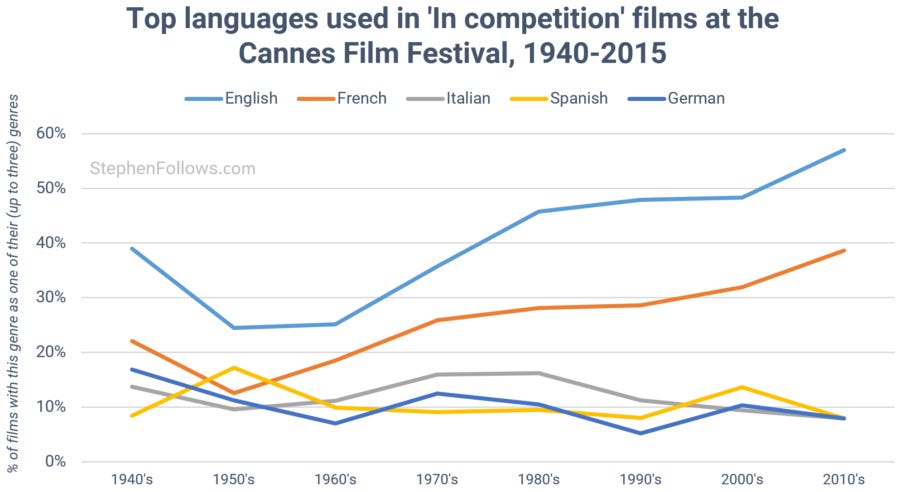
Interestingly, this is not necessarily about their country of origin. During the 1940s, 100% of German films were in German, whereas by 2010s that had dropped to 24%
Further reading: Is English becoming the de facto language of Cannes films?
40. Asian buyers are becoming more frequent at film markets
Cannes is just one of three major film markets in the film industry's annual calendar. The other two are the European Film Market (EFM) and the American Film Market (AFM), both of which have also seen attendance grow in recent years. The country of origin of AFM attendees reveals a change in the global film business.
Over a ten-year period, the AFM saw a 354% growth in numbers of film professionals from China, a 128% uplift in people coming from South Korea and a 74% growth in those based in Russia. Countries moving in the opposite direction include Belgium (which saw a 48% decline), Japan (44% decline) and the Netherlands (28% decline).
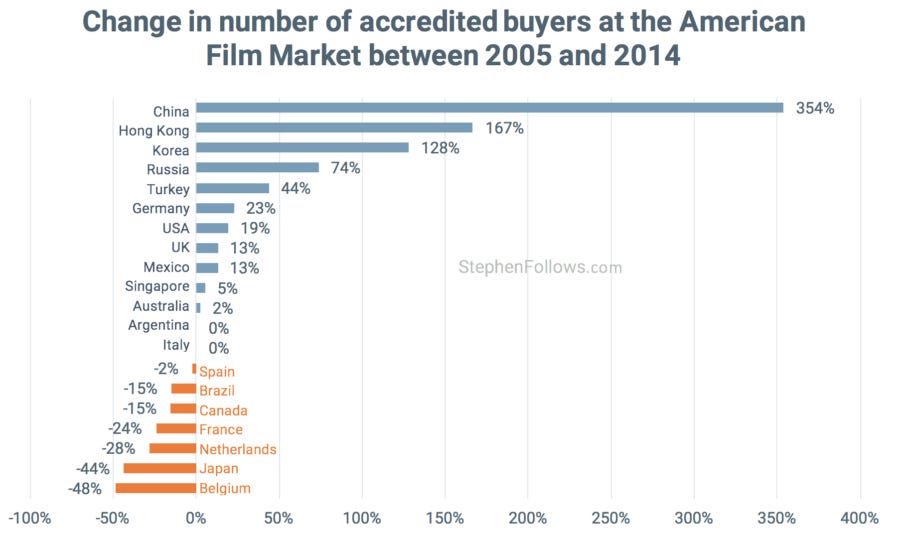
Further reading: How many people attend the American Film Market? and How big is the European Film Market?
41. The Chinese market is growing at a ridiculously fast pace
Perhaps one of the most significant changes in the film business over the past decade is the incredible rise of the Chinese market. The film economy in China is highly regulated and foreign films are subject to tight quotas. In the past decade, these quotas have been repeatedly widened and the Chinese government has relaxed rules about foreign products and money coming into the country.
These new liberalisations are minimal, and heavy controls are still in place, but as China has a population of almost 1.4 billion people, even a tiny change can bring in vast amounts of money. China has become the biggest international film market and is currently on course to outstrip even North America in the coming decade.
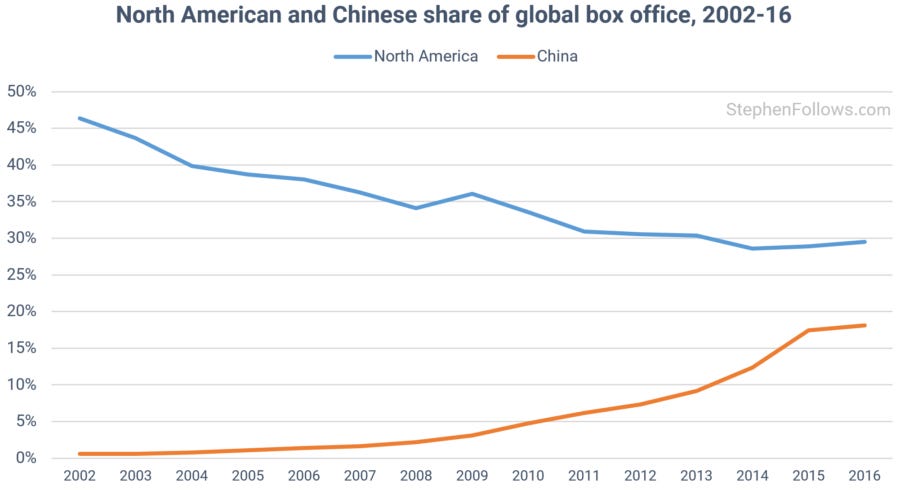
Hollywood studios are falling over themselves to get a piece of this new, potentially massive market. Early successes have shown them how important Chinese consumers can be to their bottom line. Fast and Furious 8 grossed almost $400 million in China - way above the $220 million it grossed in North America. However, exporting films to China is not without its challenges. These include:
A small number of quota spots which all distributors have to compete for.
Strict rules on content and unique censorship restrictions.
Opaque business practices and poor data collection.
Possible corruption and manipulation of official figures.
Restrictions on company ownership and control.
A far less generous distribution split (compared with the rest of the world).
The need to stay in the favour of the Chinese government.
Further reading: The rise and rise of the film business in China
42. Netflix's production arm is growing in scale and speed
Hollywood studios were slow to embrace the potential of Video on Demand (VOD), and to some degree are paying for that reluctance in the form of new competition from subscription VOD services who are able to produce and distribute their own big budget productions. In 2015, Netflix released eight self-produced feature films. In 2016, this shot up to 28 and 2017 saw a similar number (26).
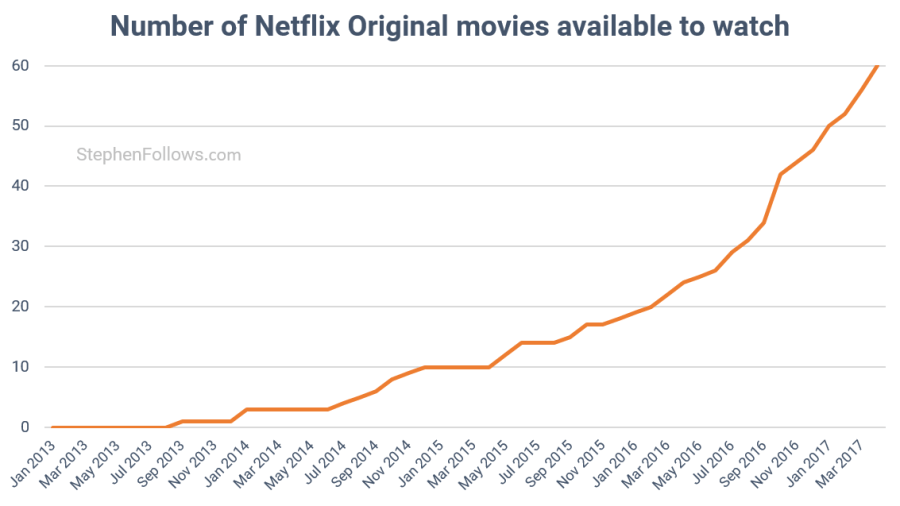
Netflix's biggest movie to date is Bright, a $90 million blockbuster starring Will Smith and directed by David Ayer (Suicide Squad). In what seems to be a common occurrence for Netflix Original movies, film critics have been harsh but Netflix has been supportive, already commissioning a sequel.
Further reading: The numbers behind Netflix Original movies and TV shows and The economics of Netflix
43. Amazon Studios is a new force in arthouse production
Netflix are not the only major player in the big-budget SVOD market, with Amazon also looking to increase market share via original movie production and exclusive acquisitions.
Interestingly, Amazon's approach seems to be markedly different from that of Netflix in two ways.
Firstly, while Netflix has sought to create broad crowdpleasers (such as their four-picture deal with Adam Sandler and poorly-received Bright) Amazon have backed smaller, more arthouse fare such as Manchester by the Sea, The Big Sick and Chi-raq. This was reflected at the 2017 Oscars where Amazon-backed films were responsible for winning three Oscars. In addition, Amazon proudly declared that fifteen of the 2017 Sundance nominees are available to watch on Amazon Prime.
Secondly, Amazon seems to be more open to flexible arrangements with filmmakers. Some Amazon-backed projects have been released in cinemas before appearing on Amazon Prime, whereas Netflix appears unwilling to allow movies an exclusive theatrical window (Netflix tried opening films in cinemas on the same day they appeared to stream on its site, but cinemas roundly rejected this model). Amazon has also made some of their original movies available on SVOD platforms other than Amazon Prime, including Hulu and arch-rival Netflix.
It remains to be seen how this approach continues as the SVOD wars heat up.

Further reading: The subtle war that’s dividing Netflix and Amazon
44. Movie production is booming in India, South Korea and Italy
South Korea, Italy, India and America have all seen the number of films made in their country increase by more than 50% since 2007.
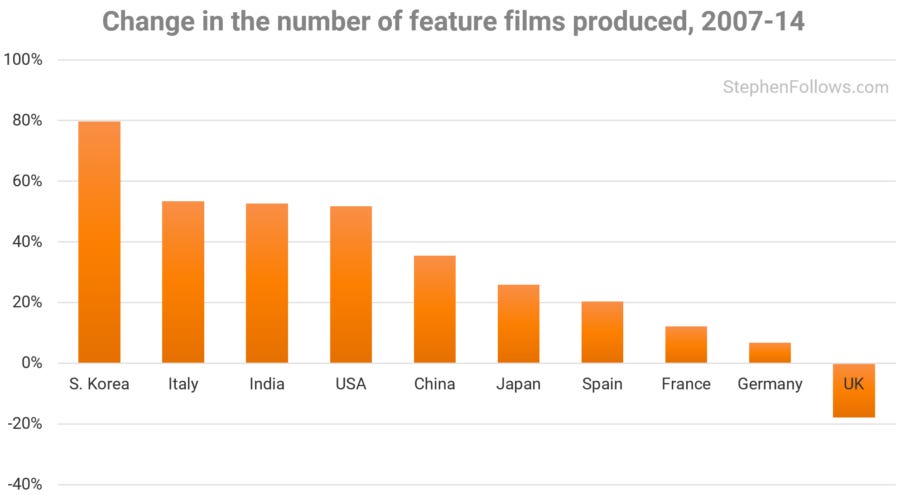
Further reading: How many films are made around the world?
45. The UK film economy is booming, thanks to American "British" productions
The previous trend focused on production levels, but this is not the only metric for assessing the strength of a country's film sector. For example, although the UK has produced far fewer movies, its overall film economy has grown thanks to a big decline in micro-budget production and an increased serving of big-budget Hollywood productions.
Between 2010 and 2016, the overall number of films made in the UK declined by 47% but the total amount spent on film production grew by 23%.
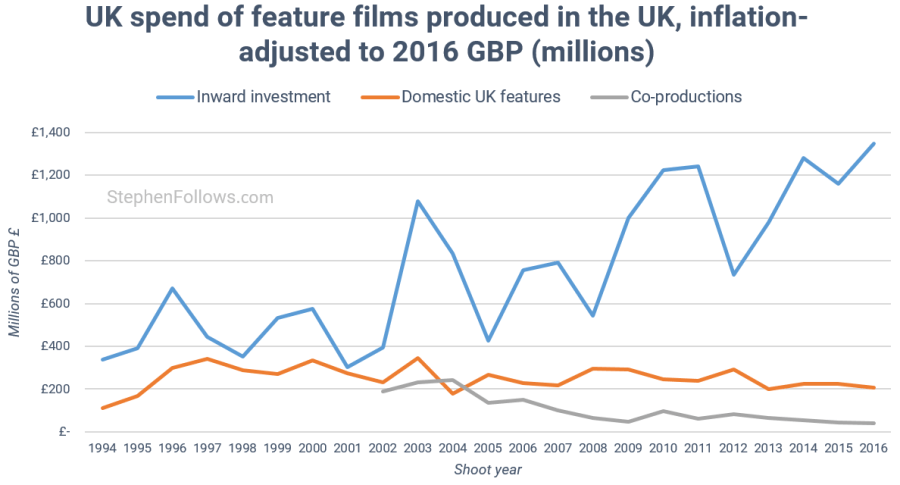
This is in large part due to the generous, stable and predictable Film Tax Relief offered to all "British" feature films shot in the UK. This typically equates to just under 20% of the cost of shooting in the UK and therefore has proved highly effective at attracting Hollywood productions. In order to qualify for the tax credit, a film must be officially classed as "British", although the rules are so wide that it would be tricky to shoot in the UK and fail.
The recent influx of "British" films includes Avengers: Age of Ultron (which received £31.9 million from the UK government), Thor: The Dark World (£25.6m), Muppets Most Wanted (£6.7m) and Maleficent (£23.5m).
Further reading: How much of the UK film economy comes from abroad? and How much has the UK government paid in film tax breaks?
46. Submissions to major film festivals have boomed
Film festivals are an under-researched sector of the film industry, so it is difficult to identify sector-wide trends. However, one change I have spotted is that the largest film festivals have experienced an increase in the number of submissions over the past few years.
Most festivals only publish headline figures of their submission volumes, but Raindance went one step further and opened up their entire books to me. This allowed me to track the growth of online submissions and how much they had increased by. In 2015, they received four times as many short films as they had six years previously.
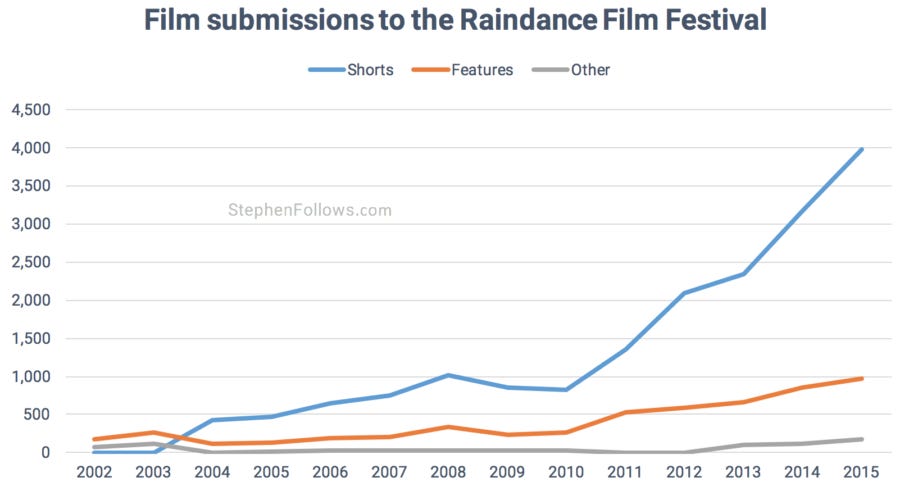
This is likely due to the increasing ease with which people can make films and innovations in the process of submitting to festivals online. The story of how film submission processes have changed in recent years is surprisingly dramatic. If you do not already know about the battle between Withoutabox and FilmFreeway then I highly recommend you read these two articles (in this order) The seismic shift in the world of film festivals and What’s changed in the world of film festivals?.
Further reading: Full costs and income of a major film festival – Raindance Film Festival and How many film festivals are there in the world?
47. The industry is feeling the effects of increased access to knowledge and technology
A study last year found that 75% of children (aged six to seventeen) said they would consider a career in online videos, presumably as YouTube stars and/or being a vlogger. Whilst this isn't exactly the same as wanting to become a filmmaker, film director or any other member of the key creative team behind a feature film, it does show just how wide and mainstream access to filmmaking has become.
Part of this shift has been the huge amount of information and training which is available online to people interested in film. By reading the right articles and watching the best YouTube / Vimeo channels, it is completely possible for someone to build their own film school for free, on their schedule and highly tailored to their abilities and interests.
In addition, software used by industry professionals is often available to pirate illegally, as are free trials or as 'educational' versions with limited features. This smashes a key barrier to entry which used to exist in the industry. One reflection of this is the falling prevalence of apprentice editors. In 1997, more than one in five films credited an apprentice editor whereas in 2016, the figure had fallen to below one in twenty.
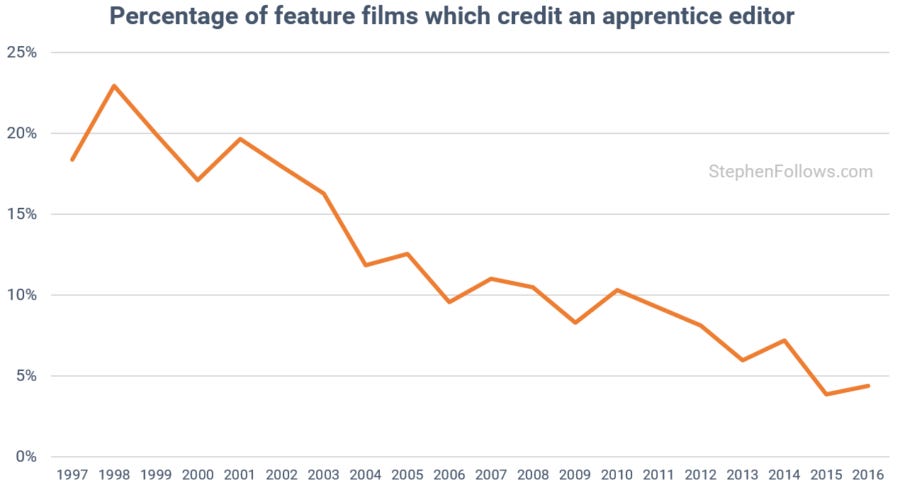
Further reading: How many editors does it take to edit a movie? and The world's best film school is free on YouTube
48. Emerging filmmakers can earn money outside of the traditional model
Following on from the previous trend, these new and emerging filmmakers do not need to follow the path of previous generations when it comes to forging a sustainable career. In the past, the only route to financial success was to work your way up slowly within the existing structures or to go down a hail mary route of trying to convince rich investors to back you.
However, today we have two very powerful routes to build a filmmaking career in an accessible, scaleable and sustainable way:
Ad-supported model, via sites like YouTube. Content creators can earn money based on the number of views their content receives. As the channel grows in attention and prestige they will likely be offered premium advertising deals and brand sponsorship. The highest-earning YouTuber of 2017 was a 26-year-old from Aldershot, England who got his start by sharing videos of himself playing Minecraft and Pokemon. His name is Daniel Middleton and last year Forbes estimated his 2017 income to be $16.5m (£12.3m).
Voluntary donations from fans, via sites like Patreon. If a filmmaker is making content for a motivated niche audience then they can often earn additional income by asking their most loyal fans for regular donations in return for premium access and content. The vast majority of Patreon backers only give a few dollars a month to their chosen content creators but this can quickly add up. The most successful Patreon creator is currently the Chapo Trap House Podcast, which grosses $92,000 a month from almost 21,000 patrons.
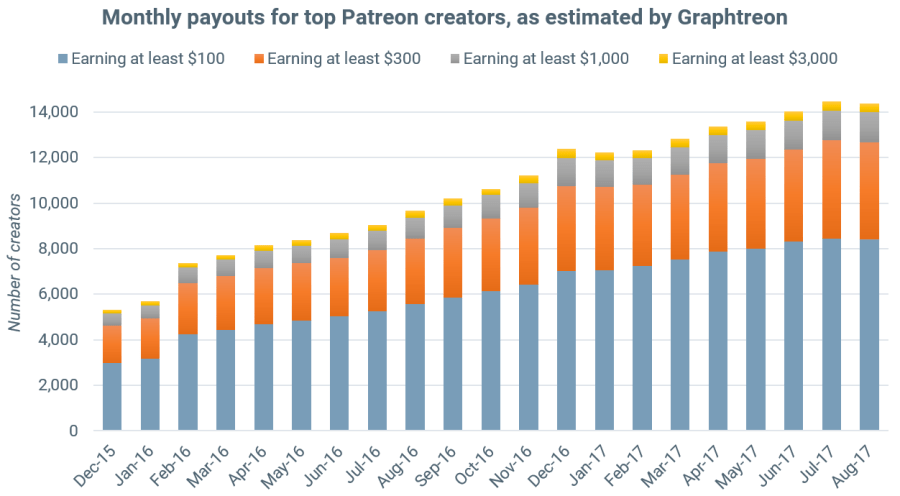
These two models can be used together and both have zero barriers to entry, beyond hard work and talent (ok, it helps if you're good-looking and outrageous but that's true of most areas in life!) In addition, both allow content creators to earn money as they grow, rather than the dilemma faced by many new entrants to the film industry: when to quit their 'real' job and try to earn a full-time living in film.
The most common routes to success in the film industry haven't changed in 100 years, but if these new models continue to grow, then maybe we should expect the next generation of top filmmakers to emerge not from short films and film festivals but from YouTube and Patreon.
Further reading: A data dive into Patreon
Notes
The data for today's article came from a variety of sources, including Oxford Economics, National Bureau of Statistics of China, IMDb, Box Office Mojo, The Numbers, Wikipedia and the BFI. If you want to know more about a particular chart then I suggest following the 'Further Reading' link as it will provide more context and details of the data source(s).
The Cannes data for the 2010's listed above covers 2010 to 2015 inclusive, as that was when I last crunched the numbers. It's also worth noting that I assigned up to three genres per film, hence why the totals add up to more than 100%.
Epilogue
This has been a long list and I have covered most part of the industry in some way over the past four weeks. However, I don't think for a minute that it's complete nor that I have covered everything which is changing in film. This list was created based on research I have conducted myself and outside research I've read so it's completely possible I've left important things out.
If you think I've missed anything then please do contact me via my contact page or leave a comment below.


